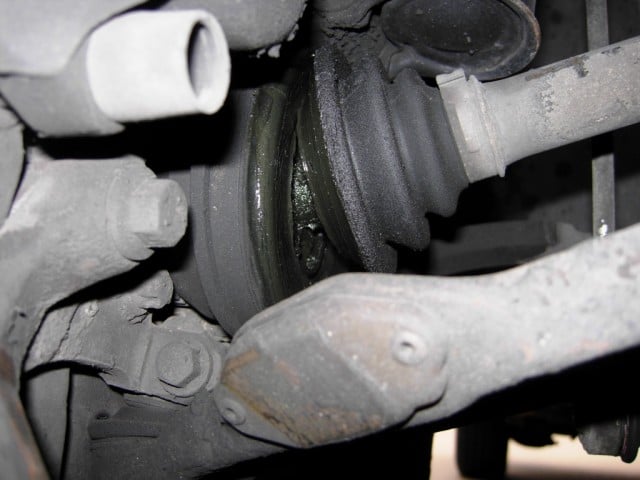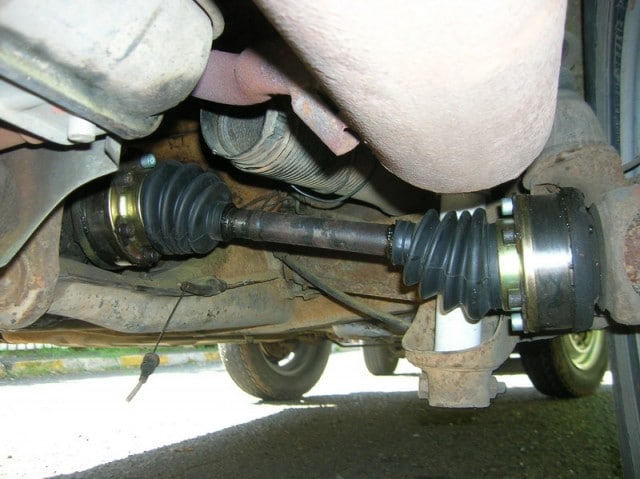Bad CV Joint Noise: Clicking Rattle Sound & 4 Other Symptoms
Before we start digging into what causes bad CV joint noise, let’s look at what it actually is and a little bit of its history.
CV joints are special types of joints that allow the wheels of a car to turn while the suspension is moving upwards and downwards. The CV joint is located at the end of the axle and connects the axle to the wheel.
CV joints allow the wheels to turn even when the suspension is moving, which makes it possible for the car to drive over bumps and potholes without the wheels losing contact with the ground.
The modern and most frequent and successful version of the CV joint, with a ball and cage, was invented in 1928 by Alfred Hans Rzeppa. For this reason the CV joint was also known as the Rzeppa joint .
An engineer for ford, he did not invent the entire concept, but he did invent the most common version and most successful. The Rzeppa joints or CV joints usually have six balls, however there are versions with three balls as well.
The Modern CV Joint Explained
The CV Joint is part of the constant velocity axle where it can be found on both the side of the gearbox as well as the wheel side. It is protected by a special encasing or slipcover protecting it from dirt and moisture.
There are two main types of CV joints: inner and outer. The inner CV joint is located at the end of the axle, near the wheel. The outer CV joint is located at the end of the driveshaft, near the differential. Both types of CV joints are lubricated with grease to keep them from wearing out.
When you are in doubt as to whether your CV joint is still in perfect working condition there are several ways to check that out. First of all, when your entire CV axle is showing some leeway you will notice it sooner or later. The cause of it is usually space in between the universal/cross joints.
These universal joints are there to absorb the motion of both the horizontal axis and the movement of the vertical axis. If you have a car with rear-wheel drive it is easy to determine whether or not the CV joint is giving out.
What you do is you grab hold of the constant velocity joints with your hands, on both the left and the right side of the universal joint and by making a rotating motion you will be able to feel the leeway. If it is too difficult try removing the outer CV joints first.
What Does a Bad CV Joint Sound Like?
 The first obvious sign of a bad CV joint is clicking noise. The noise is usually a thumping or clicking one. What happens when a CV joint wears off is that the rubber boot degrades.
The first obvious sign of a bad CV joint is clicking noise. The noise is usually a thumping or clicking one. What happens when a CV joint wears off is that the rubber boot degrades.
When this happens the clamps on either side of the CV rubber lose their tension as the rubber degrades further. This causes you to lose lubricant or grease when the axle spins.
You get the effect of what happens similar to when you swing a bucket around in a circle. The water gets pushed to the back of the bucket and thus you are able to swing the bucket upside down without the water falling out. This is caused by the centrifugal force that pushes the water to the outer side of the bucket.
Also, this outer side is of course the bottom of the bucket. The same effect can be seen when the rubber starts degrading. Cracks show, tension loosens and through the centrifugal force the grease is slowly pushed outwards. Wearing and tearing even faster.
Another way of finding out if the CV joint sound is actually what you think it is, a worn CV joint, is by listening when driving at high speeds. CV joint noise, and an often occurring vibration should be felt and heard when you accelerate.
Take your foot off the gas and the vibration should stop or lessen. This rules out any form of tire imbalance issues and pinpoints it on the driveline. If you have a CV joint in your hands, try shaking it to hear any strange noises. It should not make sounds except for the obvious.
5 Most Common Symptoms of a Bad CV Joint Sound
You may have a faulty CV joint if you hear a clicking noise from your car. Here are some other symptoms of a failing CV joint:
#1 Clicking Noise When Turning
This is the most common symptom of a worn-out CV joint. The CV joint is likely the culprit if you hear a clicking sound whenever you turn the steering wheel.
Sometimes this type of sound is also referred to as a growling noise or grinding noise. It’s caused by the CV joint moving in and out of its socket as you turn.
#2 Vibrations
Another common symptom of a bad CV joint is vibration. If you feel vibrations coming from the front of your car, it’s likely due to a worn-out CV joint.
When a CV joint is in this condition, it will not be able to balance properly during rotation and the more you accelerate. The resulting vibrations are very intense!
#3 Grease Leaks
Another sign there is a problem with your CV joint is grease leaks. If you notice that your vehicle is leaking grease from the front of your car, it’s likely due to a faulty CV joint.
The darker the color of the grease stains, the more damaged the CV joint is. This inner CV joint clunk causes the vehicle to start making noises when driving straight or making turns.
#4 Faulty CV Boots or Boot Clamps
If you have damaged or cracked boots, they will begin to leak grease, which can cause an accumulation of dirt on the joint. This leads over time toward faster wear and tear and a possible complete failure of the CV joints.
You may also notice a squeaky or clunking sound from your joint area. This means you will need to check the CV boots as well as the CV boot clamps. When these clamps are damaged, the boots will loosen up, allowing the grease to leak out.
#5 Lack of Lubrication
If your CV joints are not well-lubricated, it can cause them to make noise each time the axle starts turning.
This means that you will notice inner car noises when driving at a speed that becomes louder in certain conditions, like driving through potholes or curbs and frequenting their locations on roads with rough surfaces.
The Composition of CV Joints
 A CV joint, short for constant-velocity joint, is made up of an outer cup that is connected to the axle trunnion on the wheel side or the inner side plus an inner framework that is attached to the axle.
A CV joint, short for constant-velocity joint, is made up of an outer cup that is connected to the axle trunnion on the wheel side or the inner side plus an inner framework that is attached to the axle.
On both ends you will find ball tracks where in the balls are able to roll. The balls are contained in a ball cage. The balls are lubricated with graphitized grease which is contained by the CV cover.
How To Remove A Bad CV Axle?
Replacing CV axles is a lot easier when doing it to a rear-wheel drive. Front wheel drive vehicles make it a lot harder. Note, these type of cars also put a lot more strain on the CV joint. When you have a front-wheel driven car, removing the CV joint includes a lot more work.
It will be possible that you will have to remove a part of the suspension first. After the car has been jacked up and the front wheels have been removed you can commence unscrewing the suspension.
If the locknut on the end of the disc brake has been unscrewed and removed and the king pins and rod ends have been removed, the hub where the disc brake has been attached to, may be removed.
To be able to reach the CV axle properly it would be wise to sometimes remove the entire strut. In other cases though, just removing the hub will be more than sufficient.
Not Sure What Is Going On Inside Your Car?
Call in an expert to diagnose your vehicle. An expert can help you give proper advice and usually find the problem much faster than a person can do himself. The benefits of going to an expert is that you will be able to prevent high costs that would otherwise be incurred.
By going in soon and getting it checked out, you could keep a small issue small, instead of it deteriorating further. This can cause further damage and even end up causing potentially dangerous situations.
When consulting an expert you can always ask what the costs are of the diagnosis and to not do immediate repairs without first consulting with you about the costs. If the problem is quick to be found an expert can almost always give you an estimated cost for the repairs.
Note that it is usually split between labor and material costs, depending on what needs to be replaced or just repaired costs can vary greatly. So prevent high repair and replacement spendings, and keep you and others around you safe on the roads. Let an expert check it out for you.
Faulty CV Joint Replacement Costs
If you notice a weird knocking sound when you are turning the steering wheel of your car, it is likely that you have a problem with your CV joint. The CV joint is located at the end of your axle and helps to keep the wheels turning smoothly as you drive.
A damaged CV joint will need to be replaced. The cost of replacing a CV joint will vary depending on the make and model of your car, as well as the specific problem that you are having. However, on average, you can expect to pay between $150 and $900 for a CV joint replacement for your suspension.
Last Updated on: February 21, 2024

